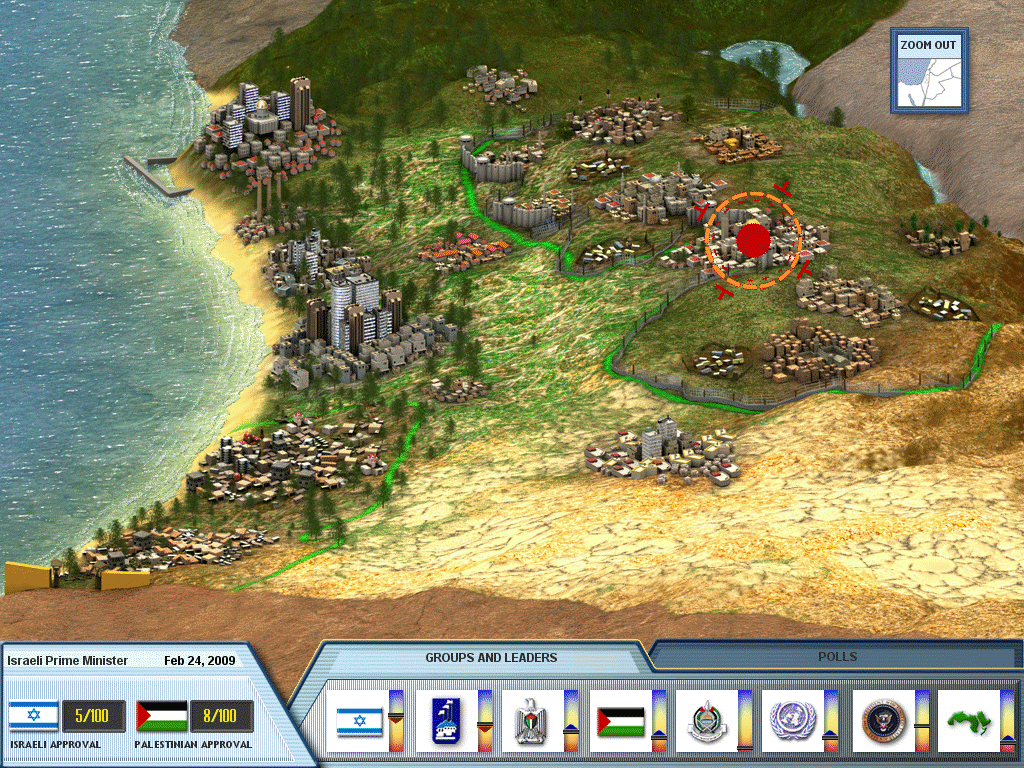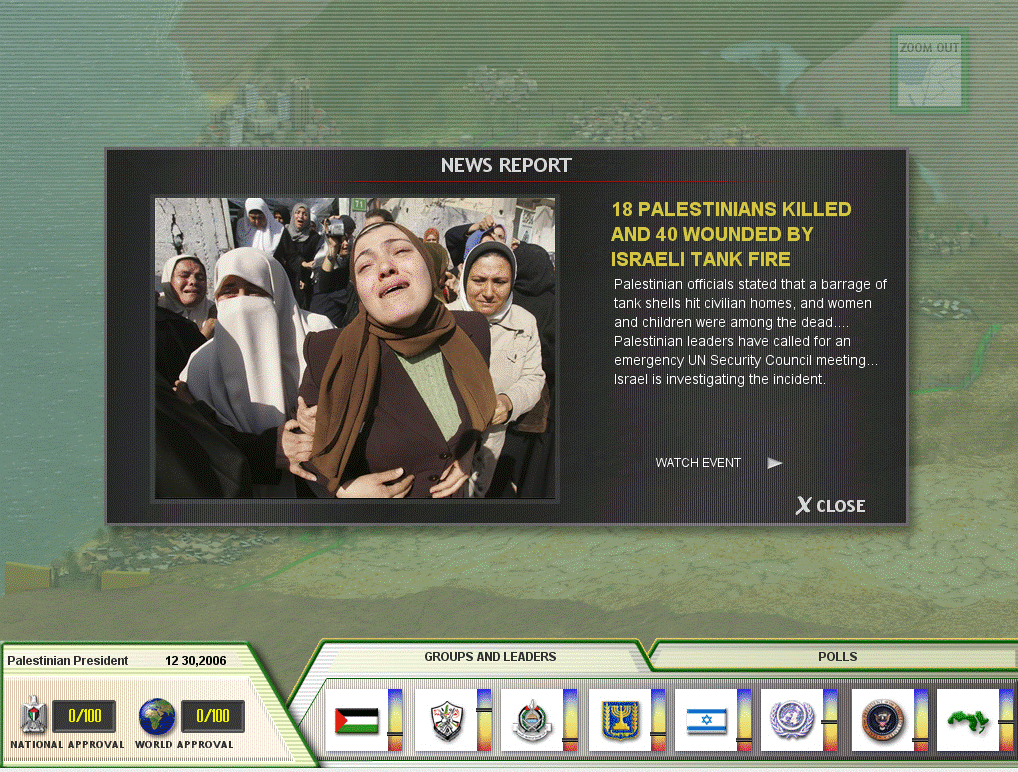Introduction:
Peacemaker is a non-traditional strategy game where the player assumes the role of the Israeli Prime Minister or the Palestinian President. The player is given the goal of either peacefully uniting Israel and Palestine under Israel or peaceful division of Palestine from Israel. The purpose of this game is to inform the players about the situation in the Middle East and give options for peaceful resolution.
Below is a detailed analysis of this game roughly following Brian Winn's1 Design/Play/Experience framework, including:
Learning
The purpose of this game is to both influence player opinion on the Israeli-Palestinian conflict and to provide information to the player about real-world events. The game does this through in-game events which are video clips or snippets of newspaper stories take directly from real-life occurrences. Surprisingly, Peacemaker does an excellent job of remaining objective and fair towards both sides. Rather than taking a particular side or showing any bias, Peacemaker shows that both sides in the Israeli-Palestinian conflict are at fault, and that in order to end hostilities, both sides need to be willing to work together. Although the game never directly states this, it uses the story of the game to impose a peace-oriented mindset on the player. Players are punished if they try and play as an Israeli or Palestinian hardliner. Peacemaker is also an extremely difficult game in many regards. It demonstrates how hard it can be for Israeli or Palestinian leadership to broker deals between the two sides while keeping public opinion high.
Storytelling
Peacemaker gives the player the option to play as either the Israeli Prime Minister or the Palestinian President. As such, the game can be played from the two separate viewpoints. When the player is starting the game, they are given three difficulty levels that determine how many events occur during gameplay. The story in both the Palestinian and the Israeli shares a lot of similarities, but plays out very differently.
Under the Israeli scenario, the player must respond to civil unrest and terrorist acts. The outcome of the story widely changes depending on the actions of the player. If the player favors the Israeli population by bolstering security and allowing the expansion of Israeli settlements into Palestinian land, the situation will escalate into a violent conflict. If done enough, the player will be informed that their current situation is unsalvageable and the game will end. In stark contrast, if the player favors the Palestinian people over their own population, unrest will rise in the Israeli government and the player will lose the support of the voting population. If angered enough, the public will impeach the player, also ending the game. The player only sees positive changes in the story if they successfully mediate compromise between the two sides. Failure to appease one of the two populations means that the story ends quickly.
In the Palestinian mode, the story and flow of events remains similar, but also has a few notable differences. Round events are more focused on Israeli government actions than the actions of Palestinian extremist groups, and outside foreigners play a much larger role than with the Israeli campaign. Rather than appeasing Israel, Palestine is focused on gaining the support of the Palestinian people and the world. As the game progresses, Israel makes several incursions into Palestinian territory. If the player wants to progress the story, they have to counter these acts by mediating peace rather than supporting extremist groups like HAMAS or by allowing Israel free-reign.

Gameplay
Despite this, the game does display elements of an agenda; the game ends extremely quickly if the player tries to play as another other than a mediator. Playing as an Israeli warhawk or a Palestinian extremist, although an option, ends the game extremely quickly. Gameplay is fairly limiting, and the player is given only a few "correct" methods for completing the game. Attempting to diverge from this set strategy is heavily punished in the game, and players who do so usually find their games end quickly. As a result, once the player has beaten the game once, there is no reason to return. While the game allows players to adopt other strategies or tactics, there is only one "correct" way to play Peacemaker, which severely hampers its replaybility. If the player tries to play the game incorrectly, their game ends early and they are forced to start anew. This can be sudden and incredibly annoying, especially because the game cuts off the player without warning. Despite this, the first several runs the player tries are interesting and fun, and the game only loses its appeal once the player realizes what they must do to win.
User Experience
The user interface is organized but can be overwhelming for the new player. While it is clear the player only has one action a turn, the sheer amount of actions the player can take makes this a little unbearable. Rather than given a straight-forward list of all actions the player can take, the player is presented with three separate tabs. This almost gives the feeling that these tabs are separated by function rather than category. For instance, increasing police forces is kept in the security tab, while Additionally, some icons (such as the ones at the bottom) can be confused for action tabs. The game layout could use a significant overhaul in this regard to make it more clear which things are action tabs and which are information tabs. Several times, I found myself clicking tabs which I assumed were information tabs only to realize I used a turn doing that action. Finally, some actions in the game are not fully explained. With no descriptions or text outside their icon, it can be difficult to determine what every button does. The advisors help clear some of this up for the player, but they don't cover every aspect. Adding more clarity to the game interface would be an easy step to making the game more coherent.
Technology
The game itself is very simple, and doesn't have very high requirements. The game itself is only about 230MBs, and could easily have been made using older technology. Layout wise, it resembles a traditional map-based strategy game, but the map itself serves no purpose other than to provide a visual sense of setting and to show the location of different events in the game.
One minor annoyance is the game's dependence on Apple Quicktime. While the game can be played without it, Quicktime is necessary if the player wishes to access in-game videos and hear in-game sound effects. Even with Quicktime installed, it is possible for the game to not detect it, leading to a very bland experience.

Assessment
Peacemaker has been met with fairly positive reviews. The game has scored, on average, a 7.5/10 which is a great score given the type of game Peacekeeper is. Many reviewers found the game to be informative, engaging, and unique due to its multiple, asymmetric perspectives. Some reviewers were critical about the lack of information regarding economic status or proper explanation about the results of your actions. While some reviewers found the game lacking in interactivity, many felt that the game was quick and interesting.
Conclusion
In conclusion, Peacemaker is a very well made game and can be both informative and interesting for short periods of time. The game is ultimately hampered in both its complex and large amount of options and its disregard for alternate play styles. Although its lack of viable options damage the game's replayability considerably, the first couple times a player tries the game it is fun and interesting while informative. It should also be noted that the developers do an excellent job remaining neutral to both sides of the Israeli-Palestinian conflict. Rather than shifting the blame to a particular side, Peacemaker emphasizes that both sides need to compromise and change if long-standing peace is to be established.
References
- Winn, Brian. The Design, Play and Experience Framework. In R. Ferdig (Ed.), Handbook of Research on Effective Electronic Gaming in Education. Hershey, PA: IGI Global, 2009, pp. 388-401.
- http://www.schmoozemag.com/wp-content/uploads/2009/04/chai-lites-peacemaker3.jpg
- http://www.impactgames.com/media/PeaceMaker-Screenshot_3.jpg